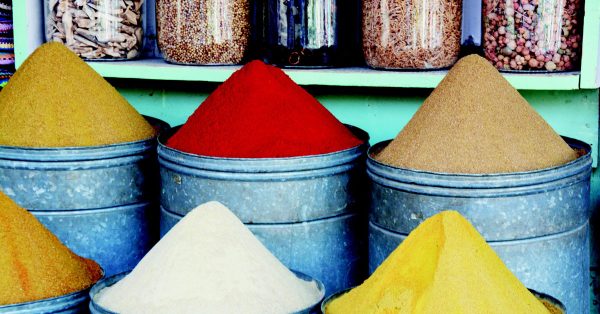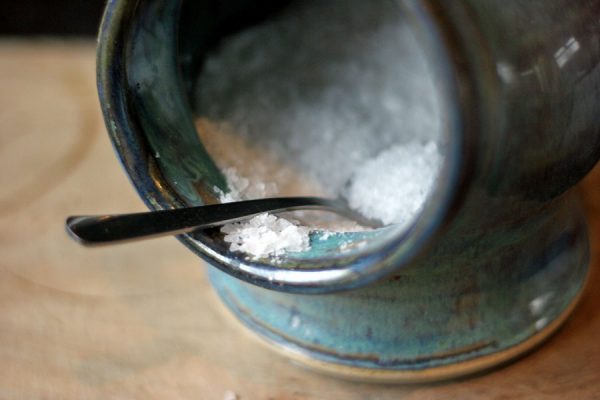By Simran Sethi

It’s all embodied, isn’t it?
The bitter taste of irony, the sweet smell of success, the way both senses culminate in what we describe as flavor. Yet every flavor represents something deeper: edible memory, embedded feeling, the flesh and bone of our life stories.
In these weeks of renewal—when spring bursts into color and birdsong, and we celebrate the Persian New Year and the Christian rebirth—I nursed a thought borne out of a high fever and deep regret over a relationship that should never have been. The heat that made my bones ache and quieted my mind enough for my heart to ask the question, what is the flavor of renewal?
What is the flavor of beginning again?
For me, it’s pomegranate. The whole fruit. The alluring but weathered skin; the thick rind; the challenge and mess of getting in there; the bitter, the tart, and the sweet. The bloody realness of all of it. It’s fucking work. And it’s worth it. It always is.

In Judaism, pomegranates are a symbol of righteousness; the multiple seeds represent the 613 precepts commanded by G-d. In Hinduism, the fruit represents abundance, the red anar cradled in the hands of both Bhūmi, goddess of the earth, and Ganesha, the elephant-headed remover of obstacles. But I resonate most with Greek mythology, in which pomegranates are connected to darkness and light. After Persephone was kidnapped by Hades, god of the underworld, her mother Demeter (goddess of the harvest) mourned her lost child, and all plants ceased to grow. Only when Persephone was returned to earth did Demeter allow the world to, again, bear fruit. But the handful of tart seeds Persephone consumed while imprisoned by Hades tethered her to the underworld forever; she would have to return again and again.
Her time on earth is marked by spring, a season that exists only because of her winter. It’s the rebirth that can only come after death; the ancient fruit that endures and returns.
*
My fever abated, but I realized I had to keep exploring what returns us to ourselves; I had to keep finding my spring. I cast an intuitive net, reaching out to authors and farmers, chefs and poets, friends and near-strangers. Together, feeding our hungers for new beginnings.
Again, I asked: What is the flavor of renewal?
Onion. Ginger. Cinnamon.
“Ginger is spiky and strong. It tastes like possibilities.” – Alice Lieberman
“Cinnamon is the beginning.” – Alice’s twin sister, Mary
Raw honey. Lavender.
“Lavender’s gentleness also reminds me to be self-nurturing, to accept, and to live every day with resiliency.” – Natalie Lorick

Hot tea. Cool water.
“That water hits my lips and sinks deep into my body. It fills me with a clarity I hadn’t known in the minutes prior. Water is my resilience. It nourishes my mind and body for whatever I need to face tomorrow. [It] is hope.” – Shanti Marie Blanchard
Fire cider. Espresso.
“Especially when your skin feels a chill and that chill clearly isn’t because of the temperature, but possibly because of the exhausted frustration of nerve endings in your skin. The electric, bracing bite of espresso with the slight sweetness of milk or sugar. It is both familiar and exotic, wound up in memories of both mornings in my childhood bed and dusty afternoons in foreign places. It tastes like this: ‘Okay, time to start over again for the hundredth first time.’” – Megan Larmer
Milk.
“Warm milk with honey, cinnamon and nutmeg. Starting over starts the night before—when you can’t sleep and can’t think and can’t not think. Measure out the milk into a green glass mug, pour it into the pan, fill a big spoon with honey, lean into the counter and stir, stir, stir until you see steam starting to rise and the sick-sweet cooked-milk smell hits you. Pour it into the cup, tap the cinnamon jar three times to let some warm powder fall, then scrape a nutmeg against the microplane and watch as the particles run from each other when they hit the surface.
Inhale.
Stir.
Grab a cat and put it on your lap, and look out at the moonlit street. Take a sip: Milk slides over the soft glass edge, honey silk hits your tongue, woody nutmeg heats you up. Let yourself get sleepy and okay with all the things you don’t know.” – Hanna Neuschwander
Ice cream. Cheese.
“I read up on the meaning of rich dairy cravings to see if it was linked to a nutritional deficiency. What I found was a link to seeking opiates and recreating the soothing benefits of breast milk.” – Priscilla Ell
“Bananas,” says one baker. (John Hinman).
“Rye bread and preserved fish,” says another.
“I have always felt that, as long as you have a tin of sardines and some rye bread (which never goes stale), you are going to be fine. It represents security for me; I come back to it again and again. It’s what I eat when I am low on money or simplifying my life but also when I encounter new people or am in new situations.” – David Bauer
“Bread,” says the coffee man.
“The complexity of life sometimes causes me to think that my needs are complex and extensive and difficult to satisfy. But they are not. Although I love and relish the sophisticated, complex foods I am exposed to, I need only the simplest of foods to keep me going. To remind myself of that is deeply liberating. I did this once, when I moved across country after a divorce, the loss of my mom and some work trouble; my food was bread. Simple, good, clean, fragrant bread. It gives me the comfort of knowing that with a little bread, and maybe some olives or soup or oranges, I’ll be just fine. No matter what.” – Peter Giuliano
The holy moment of a peach. Melon.
Honeydew melon. Clean slate. – Mike Boriello
Fresh greens. Cool mint.
“Resilience may just be the first fresh salad greens I harvest from my spring garden.” – Tamika Adjemian
“The new is something crisp and green like mint or basil. Or perhaps something I have yet to taste.” – Kasey Corbit
Verbena. Lemons.
“Beginning again is the high, clear note of lemon. The tart awakening, the puckering that also brings expansion, the sour that elicits resistance but pops my eyes wide open to see anew. This is a flavor of resilience, one that can stand alone—sliced open, bold and yellow, perched on the edge of deep water and ready to be squeezed and twisted and tossed into the depths. To take a plunge that ultimately transforms the life into which it dives, infusing it with an unmistakable, bright confidence.” – Jen Violi
Mangoes. Oranges.
“A freshly peeled orange. The spray of the juice, the peeling back of the outer skin, the pith beneath my fingernails, the piercing bright scent, the revelation of the orange flesh beneath, the dazzling dance on the tongue of familiar and new, anticipation and arrival.” – Melinda Mullin
Berries.
“A berry cheesecake, my sister’s favorite. That’s what we’ll eat when she wants to talk again.” – Elise Jeanette
Hot dogs. Dal.
“Arhar ki dal (split pigeon pea lentils) means coming home to safety after a tough day and making a resolve to begin again. It’s a strong dal that gives you shelter from the storm. It gives you the fuel to go out and take on the world again.” – Hemant Jain
What is “pulled from the sea.” – Clay Gordon
“I am Aleut and Inupiat from Alaska. My deepest self can be found in a bowl of agutuk with a piece of smoked fish on the side. It’s a place where I dwell in extreme vulnerability and optimal strength simultaneously…knowing both that we are strong enough but will never be stronger than the world around us.
Today, I live in the lushness of Northern California, so to have with me my Native foods is even more meaningful. A friend of mine is going through divorce. As soon as I found out, I rushed over with smoked fish and agutuk, Yupik-style slow-smoke salmon made outside over the course of two months, and tundra berries from Alaska. These are my Native foods, the foods of my family and my ancestors. I rushed over…to say, ‘Here I am, my deepest strength, and my greatest sorrow. Let’s us eat, to grieve and be well again.’” – Elaine Chukan Brown

Salt.
“What it ultimately tastes like is salty…like the water my family’s about to set out for our Passover meal. That symbolizes tears. In my experience, beginning again and resilience taste like every kind of tear I could cry.” – Karen Singer
Pizza.
“The way I like it, not the way he likes it. For the first time in 12 years. Pepperoni and jalapeños with extra sauce. Thin crust. All mine.” – Kathy Lynch
Green olives.
“Extra virgin olive oil is at the crux of the turning point for me and my father, and our joint venture. We started from square one, me in Rome visiting farmers and attending trade fairs, he in Japan rebuilding relationships without the backer of a famous restaurant/name. We rented a new office, opened a small wine bar and—two weeks before our first store was to open—the 2011 Tohoku earthquake and tsunami hit. Our new office was literally flooded with olive oil, dented cans and broken bottles. The store opening was delayed and shipping costs spiked. The Japanese weren’t ready to indulge in olive oil; they were in line to buy clean water.
Fast forward to today. We now have four successful stores in Tokyo and Osaka, our little wine bar has expanded to a two-story restaurant and projects are rolling in. We are just selling juice squeezed from a fruit.
Bitter, pungent, green fruit.” – Tina Cancemi
Serendipity.
It starts with the fragrance of a something that I have yet to taste in quite that way—like the discovery of carnations in a salad. It’s the unlikely duet: pineapple and pepperoni, dark chocolate and parmesan, the pairing that surprises, inviting new contexts and possibilities.
After all, to be elastic in relation to changing contexts, open to the unexpected, free of relating to food as habit, welcoming of change, is the sweetest way to nourish resilience. – Simmy Makhijani
Black cherries.
“Beginning again, for me, is not only a flavor. It is also a scent, a sensation and a context. The flavor of juicy black cherries, alive with the sun’s energy plucked right from the tree. The aroma of the cherries heated by the sun, soil, grass, leaves, dry desert air. The flavor and scents create a body-warming sensation, and the context of community (playing with my cousins) ensures the rebirth is complete.
When my body, my mind and my heart have all agreed that I’m ready for rebirth, I always come back to this memory of the cherry tree.
The flavor of ‘begin again’ is joy.” – Jeni Rogers
The pomegranate marks not only my return from darkness, but an invitation to be freed. Freed from the cold winter I hold within me, knowing it will rise again but remembering it will always burst into color and light. And joy.
Simran Sethi is the author of Bread, Wine, Chocolate: The Slow Loss of Foods We Love. Read our review here.






Leave a Reply